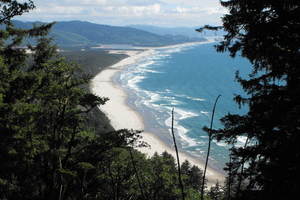
I am just back from spending 3 weeks in Oregon. What can IC members learn from that beautiful part of the world? Oregon in the Pacific North-West of theUSA shares a number of features with the Baltic Sea Region (BSR).
It is relatively peripheral within the continental land mass and in relation to the major urban centres. Like many BSR only has one major city, but a number of medium-sized towns. Thus Portland is a city approaching 600,000, though its metropolitan area is home to about 2.25 million. There are 3 other cities of over 100,000, but lots of places around the 30-50,000 mark, such as the town that I was staying in, McMinnville.
The total population of the state is less than 4 million, though like Norway is has experienced strong immigration in the last decade. The 4 million are spread over an extensive land area. The basic geography divides Oregon into 5 main parts. There is a spectacular coast with the cold waters of the Pacific, and numerous bays and headlands; then there is the coastal range of hills providing a rain shadow for the fertileWillametteValley which is where the main towns are. Further east the spectacular mountains of the Cascades raise to a snow capped 12,000 feet, and beyond is the high desert plateau.
Coastal trade and fishing, then forestry then agriculture – the primary sector of the economy remains significant. The quality of the landscape and the benign summer climate create a tourist industry. About a third of the population claim a German, Polish or Scandinavian ancestry.
 Portland
Portland
Portland has a reputation of being one of the most liveable and progressive cities in theUSA. It has been a trailblazer for urban regeneration and Richard Florida’s idea of the importance of the “creative class” to urban success. Indeed the image of the city has been turned into a comedy TV series, “Portlandia”, which plays on the quip thatPortland is the city where young people come to retire.
Walking around the Pearl District on a balmy summer evening it is easy to relate to the narrative of hipster consumerism. The area is described as “Portland’s vibrant, post-industrial neighborhood “. At its heart is the Brewery District, based on the site of a former brewery. There are wine bars, and designer shops, and loft conversion apartments from where gay couples walk their little dogs. The place could have been scripted by Florida himself. It is the archetypal, “bustling urban neighbourhood” in which converted traditional buildings stand alongside works of public art and street cafes.The Brewery District project cost $350M, with the city’s economic development body, the Portland Development Corporation providing infrastructure and parking.
Urban Growth Boundaries
One factor that helped stimulate this renaissance was the adoption of growth boundaries around Portland. These have operated since 1980. Oregon as a state has a reputation as a leading force in land use planning. From the early 1970s it set state-wide goals, that lower levels of administration were expected to follow in their plans.
The main tool to manage urban spread and to combat sprawl is then the Urban Growth Boundary. This basically sets out an area of land that can be converted to urban uses, but also specifies the timing for that conversion. Within the boundary control of development is exercised through locally determined land use zoning systems and building codes. Outside the boundary the land is protected for non-urban uses such as agriculture and forestry
Urban Growth Boundaries here, as elsewhere in the USA, have been controversial. Critics argue that they push up land and property prices, whereas supporters argue that setting boundaries helps stimulate investment on infill sites within existing built up areas, while reducing sprawl, suburbanisation and car dependency.
Public transit
Another cause of Portland’s fame is its public transit system, and in particular the light rail network that operates across parts of the metropolitan area. The integrated transit system is called TriMet and it includes free bus travel in the downtown area. There are also plans for a fast-rail connection to link Portlandto Seattle and Vancouver. At present there are hourly flights between Portland and Seattle.
Despite the acclaimed quality of the public transport system, the highways crossing and orbiting Portlandseem to be permanently congested, and the commuter area clearly extends beyond the zone served by TriMet.
Conclusions
Oregon in general and Portland in particular have enviable reputations within the USA for the quality of life that they offer. In part this is down to the positive steps they have taken to try to protect the land and stimulate reuse of abandoned urban sites. However, some critical questions still need to be asked. There are voices that argue that the creative class has not brought jobs. Indeed job growth in Portland itself has not kept pace with the performance of the regional economy as a whole (see, for example,http://blog.oregonlive.com/oldtown/2009/10/portlands_creative_class_isnt.html).
However, the urban growth boundaries do seem to have been a successful way to manage new growth. Certainly a town like McMinnville sprawls a lot less than similar towns I have seen elsewhere in the USA. However, the quality of new development is rather mundane – a mix of trailer parks for the less well-off, spacious detached housing in unimaginative layouts, and the usual clutter of commercial outlets and churches, each with extensive parking areas. It would still be difficult to live in this part of the world without a car, and you simply do not see little old ladies pushing a shopping buggy along the street or catching a bus as you do in most of urban Europe.
Perhaps the outstanding success in Oregon has been the protection of the coastline and the public access to the beaches. Legislation was passed in 1967 that guaranteed the public a right of access to all the beaches in the state. In contrast in many other states access to a beach is privately controlled with enclosed development right down to the water.
![]()